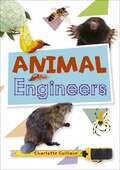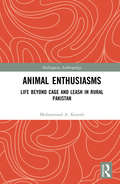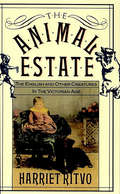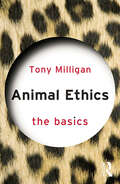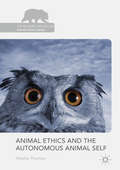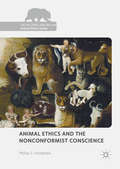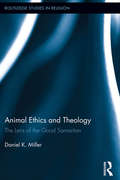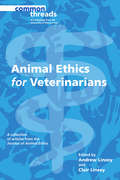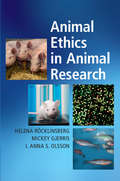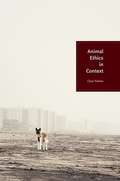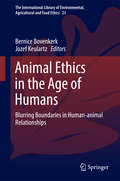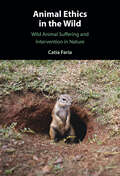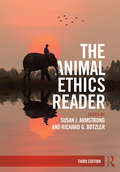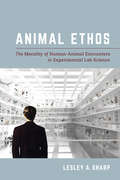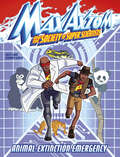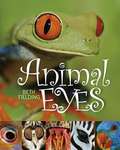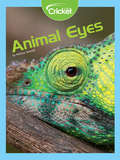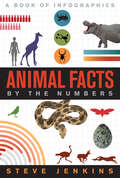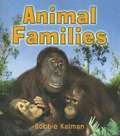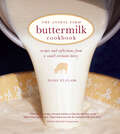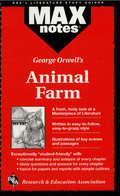- Table View
- List View
Animal Enthusiasms: Life Beyond Cage and Leash in Rural Pakistan (Multispecies Anthropology)
by Muhammad A. KaveshAnimal Enthusiasms explores how human–animal relationships are conceived, developed, and carried out in rural Pakistani Muslim society through an examination of practices such as pigeon flying, cockfighting, and dogfighting. Based on two years of ethnographic fieldwork carried between 2008 and 2018 in rural South Punjab, the book examines the crucial cultural concept of shauq (enthusiasm) and provides critical insight into changing ways of life in contemporary Pakistan. It tracks the relationships between men mediated by non-human animals and discusses how such relationships in rural areas are coded in complex ways. The chapters draw on debates around transformations of animal activities over time, the changing forms of human–animal intimacy and their impact on familial relationships, and rural Punjabi values attached to the performance of masculine honour. The book will be of interest to scholars of anthropology, multi-species ethnography, gender and masculinity studies, and South Asian studies.
The Animal Estate: The English and Other Creatures in Victorian England
by Harriet RitvoWhen we think about the Victorian age, we usually envision people together with animals: the Queen and her pugs, the sportsman with horses and hounds, the big game hunter with his wild kill, the gentleman farmer with a prize bull. Harriet Ritvo here gives us a vivid picture of how animals figured in English thinking during the nineteenth century and, by extension, how they served as metaphors for human psychological needs and sociopolitical aspirations. Victorian England was a period of burgeoning scientific cattle breeding and newly fashionable dog shows; an age of Empire and big game hunting; an era of reform and reformers that saw the birth of the Royal SPCA. Ritvo examines Victorian thinking about animals in the context of other lines of thought: evolution, class structure, popular science and natural history, imperial domination. The papers and publications of people and organizations concerned with agricultural breeding, veterinary medicine, the world of pets, vivisection and other humane causes, zoos, hunting at home and abroad, all reveal underlying assumptions and deeply held convictions—for example, about Britain’s imperial enterprise, social discipline, and the hierarchy of orders, in nature and in human society. Thus this book contributes a new new topic of inquiry to Victorian studies; its combination of rhetorical analysis with more conventional methods of historical research offers a novel perspective on Victorian culture. And because nineteenth-century attitudes and practices were often the ancestors of contemporary ones, this perspective can also inform modern debates about human–animal interactions.
Animal Ethics: Beyond Animal Rights: Food, Pets And Ethics (The Basics)
by Tony MiliganAnimal Ethics has long been a highly contested area with debates driven by unease about various forms of animal harm, from the use of animals in scientific research to the farming of animals for consumption. Animal Ethics: The Basics is an essential introduction to the key considerations surrounding the ethical treatment of animals. Taking a thematic approach, it outlines the current arguments from animal agency to the emergence of the ‘political turn’. This book explores such questions as: Can animals think and do they suffer? What do we mean by speciesism? Are humans special? Can animals be political or moral agents? Is animal rights protest ethical? Including outlines of the key arguments, suggestions for further reading and a glossary of key terms, this book is an essential read for philosophy students and readers approaching the contested field of Animal Ethics for the first time.
Animal Ethics and the Autonomous Animal Self (The Palgrave Macmillan Animal Ethics Series)
by Natalie ThomasThis book presents a radical and intuitive argument against the notion that intentional action, agency and autonomy are features belonging only to humans. Using evidence from research into the minds of non-human animals, it explores the ways in which animals can be understood as individuals who are aware of themselves, and the consequent basis of our moral obligations towards them. The first part of this book argues for a conception of agency in animals that admits to degrees among individuals and across species. It explores self-awareness and its various levels of complexity which depend on an animals’ other mental capacities. The author offers an overview of some established theories in animal ethics including those of Peter Singer, Tom Regan, Bernard Rollin and Lori Gruen, and the ways these theories serve to extend moral consideration towards animals based on various capacities that both animals and humans have in common. The book concludes by challenging traditional Kantian notions of rationality and what it means to be an autonomous individual, and discussing the problems that still remain in the study of animal ethics.
Animal Ethics and the Nonconformist Conscience (The Palgrave Macmillan Animal Ethics Series)
by Philip J. SampsonThis book explores the religious language of Nonconformity used in ethical debates about animals. It uncovers a rich stream of innovative discourse from the Puritans of the seventeenth century, through the Clapham Sect and Evangelical Revival, to the nineteenth century debates about vivisection. This discourse contributed to law reform and the foundation of the RSPCA, and continues to flavour the way we talk about animal welfare and animal rights today. Shaped by the "nonconformist conscience", it has been largely overlooked. The more common perception is that Christian “dominion” authorises the human exploitation of animals, while Enlightenment humanism and Darwinian thought are seen as drawing humans and animals together in one "family". This book challenges that perception, and proposes an alternative perspective. Through exploring the shaping of animal advocacy discourses by Biblical themes of creation, fall and restoration, this book reveals the continuing importance of the nonconformist conscience as a source to enrich animal ethics today. It will appeal to the animal studies community, theologians and early modern historians.
Animal Ethics and Theology: The Lens of the Good Samaritan (Routledge Studies in Religion)
by Daniel MillerIn this book, Daniel K. Miller articulates a new vision of human and animal relationships based on the foundational love ethic within Christianity. Framed around Jesus’ parable of the Good Samaritan, Animal Ethics and Theology thoughtfully examines the shortcomings of utilitarian and rights-based approaches to animal ethics. By considering the question of animals within the Christian concept of neighbourly love, Miller provides an alternative narrative for understanding the complex relationships that humans have with other animals. This book addresses significant theological questions such as: Does being created in the image of God present a meaningful distinction between humans and other animals? What does it mean for humans to have dominion (Gen. 1:28) over animals? Is meat eating a moral problem for Christians? In addition to drawing out the significance of Christian theology for field of animal ethics this book also engages environmental and feminist ethics. Miller brings a theological perspective to such questions as: Should care for animals be distinguished from care for the environment, and what role should human emotions play in our ethical dealings with other animals? As the title suggests, this book provides fresh insight into the theological significance of human relationships with other animals.
Animal Ethics for Veterinarians (Common Threads)
by Andrew Linzey Clair LinzeyVeterinarians serve on the front lines working to prevent animal suffering and abuse. For centuries, their compassion and expertise have improved the quality of life and death for animals in their care. However, modern interest in animal rights has led more and more people to ask questions about the ethical considerations that lie behind common veterinary practices. This Common Threads volume, drawn from articles originally published in the Journal of Animal Ethics (JAE), offers veterinarians and other interested readers a primer on key issues in the field. Essays in the first section discuss aspects of veterinary oaths, how advances in animal cognition science factor into current ethical debates, and the rise of complementary and alternative veterinary medicine and its relationship to traditional veterinary medicine. The second section continues with an essay that addresses why veterinarians have an obligation to educate animal caregivers to look past "cuteness" in order to treat all animals with dignity. The collection closes with three short sections focusing on animals in farming, trade, and research ”areas where veterinarians encounter conflicts between their job and their duty to advocate and care for animals. Contributors: Judith Benz-Schwarzburg, Vanessa Carli Bones, Grace Clement, Simon Coghlan, Priscilla N. Cohn, Mark J. Estren, Elisa Galgut, Eleonora Gullone, Matthew C. Halteman, Andrew Knight, Drew Leder, Andrew Linzey, Clair Linzey, Kay Peggs, Megan Schommer, Clifford Warwick, and James W. Yeates.
Animal Ethics in Animal Research
by Helena Röcklinsberg Mickey Gjerris Olsson I. Anna S.The use of animals in research has always been surrounded by ethical controversy. This book provides an overview of the central ethical issues focusing on the interconnectedness of science, law and ethics. It aims to make theoretical ethical reasoning understandable to non-ethicists and provide tools to improve ethical decision making on animal research. It focuses on good scientific practice, the 3Rs (replacement, reduction and refinement), ethical theories applied to specific cases and an overview of regulatory issues. The book is co-authored by experts in animal research, animal welfare, social sciences, law and ethics, and provides both animal researchers and members of animal ethics committees with knowledge that can facilitate their work and communication with stakeholders and the public. The book is written to provide knowledge, not to argue a certain position, and is intended to be used in training that aims to fulfil EU Directive 2010/63/EU.
Animal Ethics in Context
by Clare PalmerIt is widely agreed that because animals feel pain we should not make them suffer gratuitously. Some ethical theories go even further: because of the capacities that they possess, animals have the right not to be harmed or killed. These views concern what not to do to animals, but we also face questions about when we should, and should not, assist animals that are hungry or distressed. Should we feed a starving stray kitten? And if so, does this commit us, if we are to be consistent, to feeding wild animals during a hard winter? <P><P>In this controversial book, Clare Palmer advances a theory that claims, with respect to assisting animals, that what is owed to one is not necessarily owed to all, even if animals share similar psychological capacities. Context, history, and relation can be critical ethical factors. If animals live independently in the wild, their fate is not any of our moral business. Yet if humans create dependent animals, or destroy their habitats, we may have a responsibility to assist them. Such arguments are familiar in human cases-we think that parents have special obligations to their children, for example, or that some groups owe reparations to others. Palmer develops such relational concerns in the context of wild animals, domesticated animals, and urban scavengers, arguing that different contexts can create different moral relationships.
Animal Ethics in the Age of Humans: Blurring boundaries in human-animal relationships (The International Library of Environmental, Agricultural and Food Ethics #23)
by Bernice Bovenkerk Jozef KeulartzThis book provides reflection on the increasingly blurry boundaries that characterize the human-animal relationship. In the Anthropocene humans and animals have come closer together and this asks for rethinking old divisions. Firstly, new scientific insights and technological advances lead to a blurring of the boundaries between animals and humans. Secondly, our increasing influence on nature leads to a rethinking of the old distinction between individual animal ethics and collectivist environmental ethics. Thirdly, ongoing urbanization and destruction of animal habitats leads to a blurring between the categories of wild and domesticated animals. Finally, globalization and global climate change have led to the fragmentation of natural habitats, blurring the old distinction between in situ and ex situ conservation. In this book, researchers at the cutting edge of their fields systematically examine the broad field of human-animal relations, dealing with wild, liminal, and domestic animals, with conservation, and zoos, and with technologies such as biomimicry. This book is timely in that it explores the new directions in which our thinking about the human-animal relationship are developing. While the target audience primarily consists of animal studies scholars, coming from a wide range of disciplines including philosophy, sociology, psychology, ethology, literature, and film studies, many of the topics that are discussed have relevance beyond a purely theoretical one; as such the book also aims to inspire for example biologists, conservationists, and zoo keepers to reflect on their relationship with animals. ""
Animal Ethics in the Wild: Wild Animal Suffering and Intervention in Nature
by Catia FariaAnimals, like humans, suffer and die from natural causes. This is particularly true of animals living in the wild, given their high exposure to, and low capacity to cope with, harmful natural processes. Most wild animals likely have short lives, full of suffering, usually ending in terrible deaths. This book argues that on the assumption that we have reasons to assist others in need, we should intervene in nature to prevent or reduce the harms wild animals suffer, provided that it is feasible and that the expected result is positive overall. It is of the utmost importance that academics from different disciplines as well as animal advocates begin to confront this issue. The more people are concerned with wild animal suffering, the more probable it is that safe and effective solutions to the plight of wild animals will be implemented in the future.
The Animal Ethics Reader
by Richard G. Botzler Susan J. ArmstrongThe Animal Ethics Reader is an acclaimed anthology containing both classic and contemporary readings, making it ideal for anyone coming to the subject for the first time. It provides a thorough introduction to the central topics, controversies and ethical dilemmas surrounding the treatment of animals, covering a wide range of contemporary issues, such as animal activism, genetic engineering, and environmental ethics. The extracts are arranged thematically under the following clear headings:???? Theories of Animal Ethics Nonhuman Animal Experiences Primates and Cetaceans Animals for Food Animal Experimentation Animals and Biotechnology Ethics and Wildlife Zoos and Aquariums Animal Companions Animal Law and Animal Activism Readings from leading experts in the field including Peter Singer, Bernard E. Rollin and Jane Goodall are featured, as well as selections from Tom Regan, Jane Goodall, Donald Griffin, Temple Grandin, Ben A. Minteer, Christine Korsgaard and Mark Rowlands. Classic extracts are well balanced with contemporary selections, helping to present the latest developments in the field. This revised and updated Third Edition includes 31 new readings on a range of subjects, including animal rights, captive chimpanzees, industrial farm animal production, genetic engineering, keeping cetaceans in captivity, animal cruelty, and animal activism. The Third Edition also is printed with a slightly larger page format and in an easier-to-read typeface.? Featuring contextualizing introductions by the editors, study questions and further reading suggestions as the end of each chapter, this will be essential reading for any student taking a course in the subject. With a new foreword by Bernard E. Rollin.
Animal Ethos: The Morality of Human-Animal Encounters in Experimental Lab Science
by Lesley A. SharpWhat kinds of moral challenges arise from encounters between species in laboratory science? Animal Ethos draws on ethnographic engagement with academic labs in which experimental research involving nonhuman species provokes difficult questions involving life and death, scientific progress, and other competing quandaries. Whereas much has been written on core bioethical values that inform regulated behavior in labs, Lesley A. Sharp reveals the importance of attending to lab personnel’s quotidian and unscripted responses to animals. Animal Ethos exposes the rich—yet poorly understood—moral dimensions of daily lab life, where serendipitous, creative, and unorthodox responses are evidence of concerted efforts by researchers, animal technicians, veterinarians, and animal activists to transform animal laboratories into moral scientific worlds.
Animal Experimentation
by Vaughan MonamyAnimal Experimentation is an important book for all those involved in the conduct, teaching, learning, regulation, support or critique of animal-based research. Whilst maintaining the clarity of style that made the first edition so popular, this second edition has been updated to include discussion of genetically modified organisms and associated welfare and ethical issues that surround the breeding programs in such research. It also discusses the origins of vivisection, advances in human and non-human welfare made possible by animal experimentation, principle moral objections to the use of research animals, alternatives to the use of animals in research, and the regulatory umbrella under which experiments are conducted in Europe, USA and Australasia. In addition, the book highlights the future responsibilities of students who will be working with animals, and offers practical advice on experimental design, literature search, consultation with colleagues, and the importance of the on-going search for alternatives.
Animal Extinction Emergency: A Max Axiom Super Scientist Adventure (Max Axiom And The Society Of Super Scientists Ser.)
by Emily SohnCountless animals around the world are in danger of dying out! But why are species going extinct, and what happens when we lose them? In this nonfiction graphic novel, Max Axiom and the Society of Super Scientists are on a mission to find out. Using their superpowers and super-smarts, the team will break down this urgent issue into an exciting, fact-filled adventure so young readers can learn about the causes and effects of animal extinction and endangerment and discover steps we can all take to save Earth’s wildlife.
Animal Eyes
by Beth FieldingANIMALS. This bright, colorful book explores the sensational variety of eyes in the world's animals. Discover trick eyes, sideways eyes, glow-in-the-dark eyes, giant eyes, see-through eyes, and so many more. <p><p> Chameleons clean their eyes with their tongues, while camels and crocodiles have thin membranes over their eyes to protect them from damage during sandstorms and feedings. Giant squids have the largest eyes, and some spiders have eight eyes! Animals such as raccoons and tigers have accent fur around their eyes, making them look more ferocious, while animals such as butterflies and fish have fake eyes used to trick predators. <p> Fun, easy experiments that illustrate the way animal eyes work, and cool eye facts to gross out family and friends. Glossary and index included. Real science has never been so much fun! Ages 4+.
Animal Eyes
by Melissa StewartLike you, most animals have eyes. But how and what they see can be very different.
Animal Fact Animal Fable
by Seymour SimonDescribes common beliefs about animals and explains which are fact and which are fable.
Animal Facts: By the Numbers (By the Numbers)
by Steve JenkinsFrom the beloved Caldecott Honor-winning author of What Do You Do with a Tail Like This? comes another stunning, informative reader in the By the Numbers series. In this installment, Jenkins explores a wide range of facts and data about animals all over the world, some familiar, some new, but all fascinating!In this latest stunning, informative reader in Steve Jenkins's By the Numbers series, we dive deep into the world of animals and insects. From the smallest known species of snake to the sleepiest mammals, Animal Facts By the Numbers provides readers of all ages with the ultimate animal trivia knowledge.Illustrated with innovative infographs and beautiful full color art, these are books to pore over.
Animal Families (Introducing Living Things)
by Bobbie KalmanChildren love to read about different kinds of animal families. In this fascinating new book, simple text explains how animals behave toward their young in different and sometimes surprising ways, from fish and reptile mothers who leave their young to fend for themselves to male wolves and penguins who help raise their babies. Engaging photographs also show how mammal mothers teach their young survival skills and how some animals live together in groups.
The Animal Farm Buttermilk Cookbook: Recipes and Reflections from a Small Vermont Dairy
by Diane St. Clair“Through her recipes, devoted entirely to what she describes as the ‘elixir of the human race,’ Diane draws you into the rhythms of life on a farm.” —Thomas Keller, The French LaundryFor anyone who’s enjoying a return to real food, true buttermilk remains one of the great, undiscovered pleasures. Many people enjoy organic produce, grass-fed meats, and artisan breads, but “real” dairy has been slower to reach a wide market. In fact, dairy products have long been pasteurized and homogenized into bland tastelessness, with no regard to where the product came from or how it was made.On Animal Farm in Orwell, Vermont, Diane St. Clair takes butter and buttermilk production to a new level. The Animal Farm Buttermilk Cookbook explains her techniques, from animal husbandry and land management, to her creamery processes. Here you’ll learn how to make your own butter and buttermilk at home, and then experiment with the fabulous ways in which buttermilk enhances food flavors and textures.You’ll also find practical but unique recipes for using buttermilk—everything from buttermilk doughnuts dipped in maple syrup, to salmon chowder, buttermilk ricotta gnocchi, and harissa buttermilk salad dressing. Families will love the buttermilk béchamel pizza, the spicy buttermilk gingerbread, and pork chops smothered in buttermilk sauce. Buttermilk is not just for waffles anymore—although the best waffle recipe you’ll ever find is in this book!“This book beautifully shares both her life as a dairy farmer and artisan, and many of her incredible recipes, and will have you seeking out great buttermilk to cook and bake all year round.” —Barbara Lynch, James Beard Award–winning chef
Animal Farm An English Coursebook for Undergraduates - RTMNU
by George OrwellAnimal Farm is a novella by George Orwell, and is the most famous satirical allegory of Soviet Totalitarianism. Published in 1945, the book reflects events leading up to and during the Stalin era, Orwell, a democratic socialist, and a member of the Independent Labour Party for many years, was a critic of Joseph Stalin, and was suspicious of Moscow-directed Stalinism after his experiences with the NKVD during the Spanish Civil War. The book was chosen by Time Magazine as one of the 100 best English-language novels (1923 to 2005) The short novel is an allegory in which animals play the roles of the Bolshevik revolutionaries and overthrow and oust the human owners of the farm, setting it up as a commune in which, at first, all animals are equal, class and status disparities soon emerge however, between the different animal species. The novel describes how a society's ideologies can be manipulated and twisted by individuals in positions of social and political power, including how a utopian society is made impossible by the corrupting nature of the very power necessary to create it.
Animal Farm (MAXNotes Literature Guides)
by Joseph ScaliaREA's MAXnotes for George Orwell's Animal Farm MAXnotes offer a fresh look at masterpieces of literature, presented in a lively and interesting fashion. Written by literary experts who currently teach the subject, MAXnotes will enhance your understanding and enjoyment of the work. MAXnotes are designed to stimulate independent thought about the literary work by raising various issues and thought-provoking ideas and questions. MAXnotes cover the essentials of what one should know about each work, including an overall summary, character lists, an explanation and discussion of the plot, the work's historical context, illustrations to convey the mood of the work, and a biography of the author. Each chapter is individually summarized and analyzed, and has study questions and answers.
